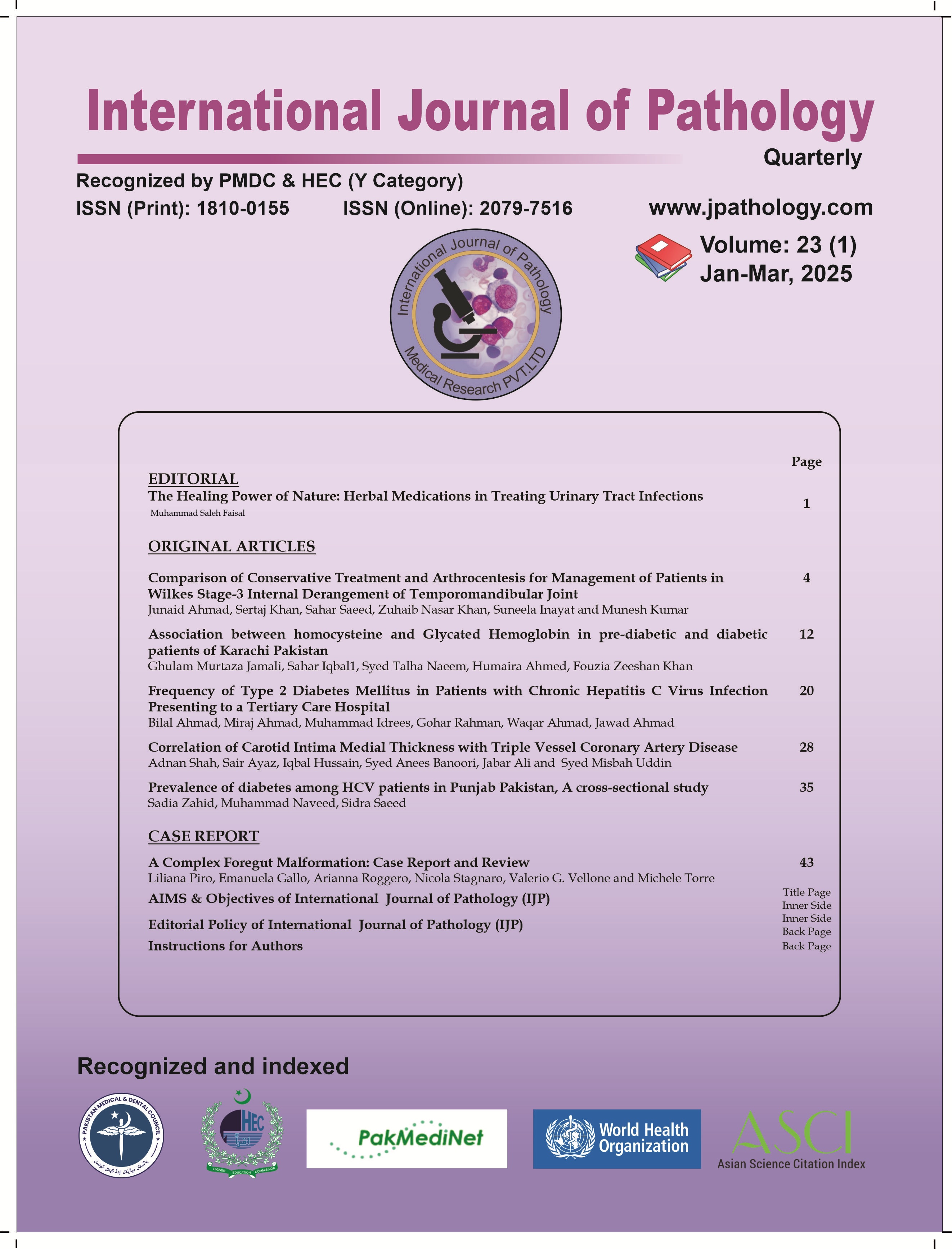The Healing Power of Nature: Herbal Medications in Treating Urinary Tract Infections
DOI:
https://doi.org/10.59736/IJP.23.01.945Keywords:
Herbal medications,, Urinary tract infectionsAbstract
Urinary tract infections (UTIs) are a significant public health issue affecting both genders; however, females are more prone to them due to differences in urogenital and reproductive anatomy, physiology, and lifestyle (1). Antibiotics such as trimethoprim, sulfamethoxazole, and quinolones are commonly used as first-line treatments for UTIs. However, the emergence of microbial resistance, along with potential life-threatening side effects, and high costs, has prompted the search for more sustainable treatment options. There is a growing interest in the use of medicinal plants and herbal remedies as an alternative or complementary approach (2). Several common medicinal plants are known to have therapeutic potential for managing and treating UTIs.
Cranberry products are widely used as popular natural and alternative remedies for UTIs. They contain various compounds, including D-mannose, hippuric acid, and anthocyanins, which may help prevent infectious bacteria from sticking to the urinary tract, thereby inhibiting their growth and ability to cause infection. Some studies have shown promising results with 90% of UTIs resolved after taking 1.5 grams of D-mannose twice daily for three days (3, 4). They are generally safe, with mild diarrhea being the most common side effect. However, people with blood glucose regulation issues should be cautious.
Uva ursi, also known as bearberry leaf, has been used in traditional medicine for treating UTIs. The plant’s berries are favored by bears, giving it the name bearberry. The leaves are dried and used to make tea or taken in capsule form. It contains arbutin, a compound shown to have antibacterial effects, particularly against E. coli, a common UTI-causing bacteria (5). However, it should be used short-term and under a healthcare provider’s guidance, as high doses can be toxic.
Green tea, made from the leaves of Camellia sinensis, has been used in traditional medicine for its antimicrobial and anti-inflammatory properties. It contains polyphenols, like epigallocatechin (EGC), which have shown antibacterial effects against E. coli. A cup of green tea contains about 150 mg of EGC, which may help inhibit bacterial growth (6). While moderate green tea intake is generally safe, its caffeine content may disrupt sleep and worsen UTI symptoms, so decaffeinated options may be better.
Dandelion (Taraxacum officinale), often dismissed as a weed, is a powerful diuretic and anti-inflammatory herb. By increasing urine production, it helps flush toxins and bacteria from the urinary system, potentially preventing the spread of infection. Dandelion also has mild antibacterial properties that support the healing process. Additionally, the root of the dandelion plant contains compounds that may aid in detoxifying the kidneys, enhancing overall urinary tract health (7).
Parsley (Petroselinum crispum) tea is rich in vitamins A and C, along with compounds that help eliminate toxins from the body. It reduces inflammation, acts as a histamine inhibitor, and scavenges free radicals. It also has diuretic effects, which are linked to its inhibition of the sodium-potassium pump, increasing sodium and water excretion while reabsorbing potassium (8). The essential oil apiole, found in all parts of parsley, is a known kidney stimulant and bladder tonic. While generally safe as a food, excessive parsley should be avoided during pregnancy due to its uterine-stimulating compounds.
In spite of the promising outlook of medicinal plants and herbal remedies, there have been difficulties incorporating them into mainstream healthcare systems. Among the greatest obstacles is a lack of organized research on the majority of the herbs. Pharmaceutical drugs are vetted through extreme testing and clinical trials, yet most herbal therapies are not under the same stringent standards. This lack of regulation can make it difficult for patients to know which products are effective, safe, and properly dosed. Furthermore, certain herbs will interfere with prescribed drugs and have adverse reactions.
The healing potential of medicinal plants and herbal medications for urinary tract infections is a testament to the power of nature in supporting human health. One of the key advantages of using them for UTIs is their ability to address the condition from multiple angles. They possess antibacterial, anti-inflammatory, and diuretic properties, with fewer side effects compared to conventional antibiotics. While medicinal plants offer promising benefits, they should not be seen as a replacement for professional medical care, especially in the case of severe or recurrent UTIs. However, when used wisely, they can work synergistically with conventional treatments, enhancing their effectiveness and potentially reducing the need for long-term antibiotic use.
References
Medina M, Castillo-Pino E. An introduction to the epidemiology and burden of urinary tract infections. Ther Adv Urol. 2019 May 2;11:1756287219832172. doi: 10.1177/1756287219832172
Popović Z, Matić R, Bojović S, Stefanović M, Vidaković V. Ethnobotany and herbal medicine in modern complementary and alternative medicine: An overview of publications in the field of I&C medicine 2001–2013. J Ethnopharmacol. 2016 Apr 2; 181:182-92. Doi: 10.1016/j.jep.2016.01.034.
Cooper TE, Teng C, Howell M, Teixeira-Pinto A, Jaure A, Wong G. D-mannose for preventing and treating urinary tract infections. Cochrane Database Syst Rev. 2022 Aug 30; 8(8):CD013608. doi: 10.1002/14651858.CD013608.pub2
Domenici L, Monti M, Bracchi C, Giorgini M, Colagiovanni V, Muzii L, Benedetti Panici P. D-mannose: a promising support for acute urinary tract infections in women. A pilot study. Eur Rev Med Pharmacol Sci. 2016 Jul; 20(13):2920-5.
Bundesinstitut fur Arzneimittel und Medizinprodukte , Mark Blumenthal, et al. The complete German commission E monographs. Therapeutic guide to herbal medicines.Ist edition,germany. American Botanical Council 1999.
Noormandi A, Dabaghzadeh F. Effects of green tea on Escherichia coli as a uropathogen. Journal of traditional and complementary medicine. 2015;5(1):15-20.
Saeed S. Herbal remedies for urinary tract infection. Int J Biol Biotechnol. 2010;7(4):347-52.
Kreydiyyeh SI, Usta J. Diuretic effect and mechanism of action of parsley. J Ethnopharmacol . 2002;79(3):353-7.
Downloads
Published
Issue
Section
License
Copyright (c) 2025 Muhammad Saleh Faisal

This work is licensed under a Creative Commons Attribution-NonCommercial 4.0 International License.
Readers may “Share-copy and redistribute the material in any medium or format” and “Adapt-remix, transform, and build upon the material”. The readers must give appropriate credit to the source of the material and indicate if changes were made to the material. Readers may not use the material for commercial purpose. The readers may not apply legal terms or technological measures that legally restrict others from doing anything the license permits.


